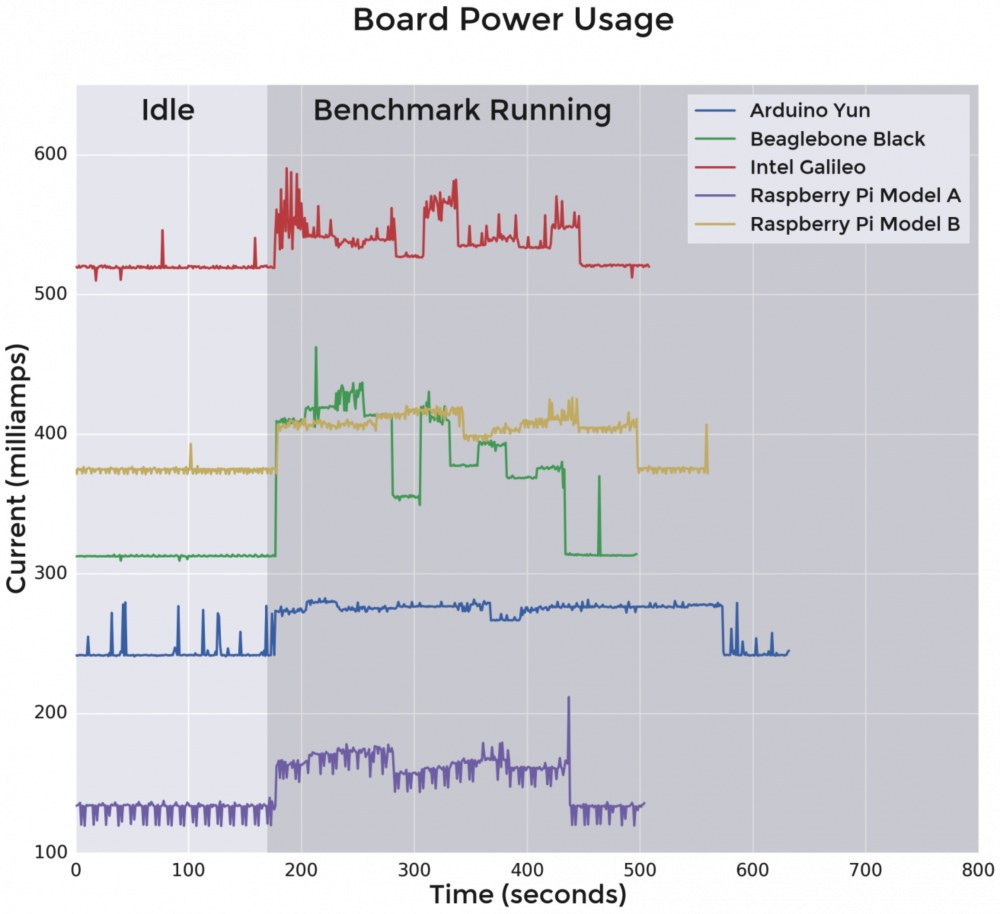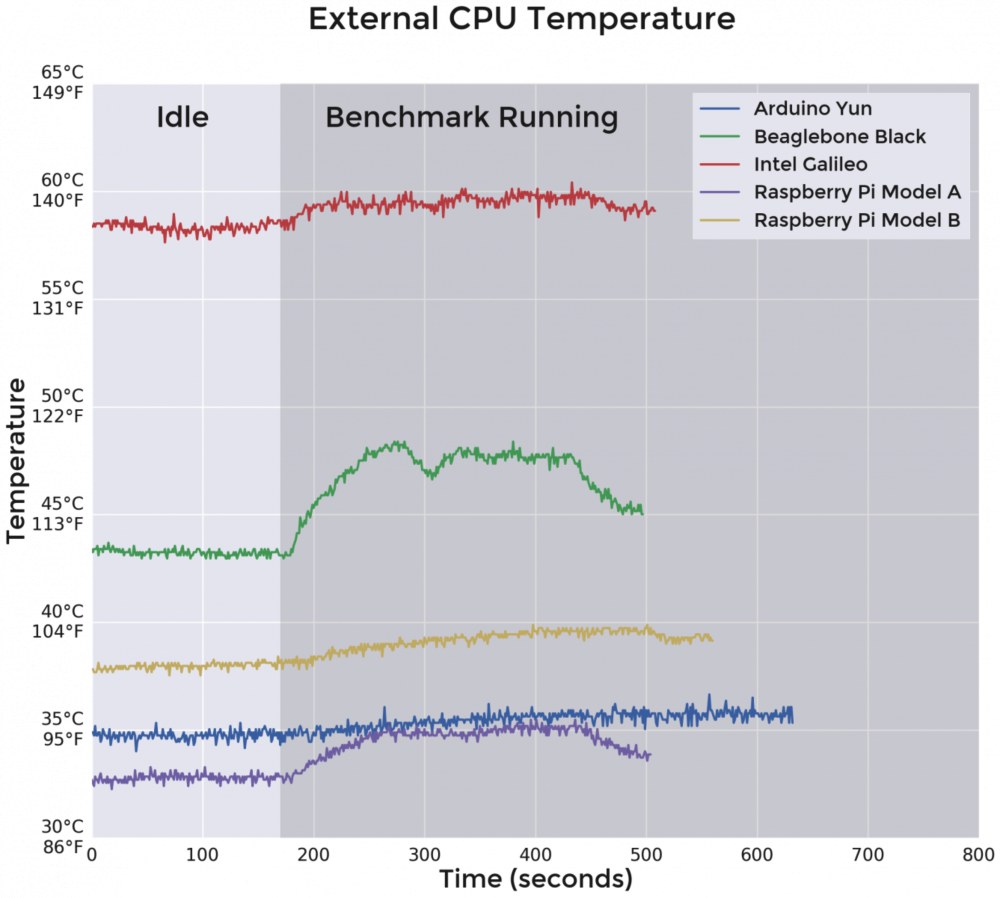Raspberry Pi, Beaglebone Black, Arduino Yun, and Intel Galileo – which one is right for you?
Part 1 – Specification and Performance
Power Usage
To compare power usage of the boards I measured the amount of current drawn by each board as it sat idle, and as it ran the nbench benchmark tool. The data from this test can help describe the low and high range for power consumption from each board.
Current usage was measured using an INA219 breakout connected to an Arduino and measuring the current drawn to each board's 5V input (either through a barrel jack or USB micro B connector).
Each board was connected to a minimum of peripherals during the test. The Beaglebone Black, Raspberry Pi model B, and Intel Galileo were connected only to a network through their ethernet port. The Arduino Yun was connected to a network through WiFi. The Raspberry Pi model A was not connected to a network, and instead connected to a USB keyboard and HDMI monitor.
 |
|
| Figure 2. | Raspberry Pi, Beaglebone Black, Arduino Yun, Intel Galileo Boards Power Usage. |
From the results above it's interesting to see the wide range in power usage. The Raspberry Pi model A is at the low end with ~150mA of average current draw. At the high end the Intel Galileo board consumes well over 500mA of current, even at idle! This large difference is likely a result of the difference in peripherals and supporting chips on each board. The Galileo has a lot of peripheral chips like an I/O extender, analog to digital converter, ethernet adapter, etc. which all consume power, whereas the model A board is just the Broadcom processor and very little else.
Both the Beaglebone Black and Raspberry Pi model B have similar power usage under load, but the Beaglebone Black is noticeably lower at idle. Even with its greater performance in the benchmark, the Beaglebone Black is slightly better at power usage than the Raspberry Pi model B.
Finally, it's interesting to see the impact of WiFi with the Arduino Yun results. While running over WiFi the Yun demonstrated low power usage compared to the other boards. To see how running other boards with WiFi would compare, I ran a quick test to measure the power consumption of the Raspberry Pi model A board at idle and under load with a small USB WiFi adapter connected. Power usage with the WiFi adapter increased by about 30-150mA, depending on network activity, which puts it in line with the Arduino Yun results. In general running a board with WiFi doesn't appear to be a dramatic cost in power usage.
Temperature
To understand how hot each board can get, I measured the external temperature of each board's CPU while running nbench. Temperature was measured using an LM35D temperature sensor held against each board's CPU with tape. The temperature sensor was connected to an Arduino analog input, and a precision voltage reference was used with the Arduino analog reference input.
Note the Arduino Yun's CPU is covered by a metal RF shield. I chose not to remove this shield and measured temperature of the shield directly above the CPU.
 |
|
| Figure 3. | External temperature of each board's CPU while running nbench. |
From the results above (Figure 3) you can see the Intel Galileo board runs quite hot, at around 60°C / 140°F. The CPU on the Galileo does not have a heatspreader or large package to absorb heat so higher temperatures like this are likely expected. According to Intel's datasheet the Galileo processor can run up to 70°C, which is in line with the data that was measured here. In general be careful of touching or obstructing the CPU on the Galileo since it is very hot to the touch.
Another interesting result is the Beaglebone Black compared to the Raspberry Pi model B. Although the Beaglebone Black has better performance and power consumption, it appears to come with a trade off of noticeably higher temperatures (about 5°C / 10°F higher).
Most of the boards run at or below 40°C / 104°F which is not excessively higher than ambient temperature (about 22°C / 72°F at the time of these tests).
Development
The software and development support of a board is just as important as the hardware. Below is a summary of the available operating systems and development tools for each board.
Arduino Yun
- Operating system is based on the OpenWrt distribution and limited by only 16 MB of space available to the entire operating system. Don't expect to find all the tools and utilities in a desktop Linux environment!
- Out of the box Python 2.7 is available for development. Other languages such as PHP or Perl can be installed through the opkg package manager.
- Unfortunately there is not enough space to run GCC and compile C/C++ code on the board. A cross-compilation toolchain must be setup to compile any custom code for the Linux environment.
- All access to the I/O is done exclusively through the ATmega32U4 processor. Programming the ATmega processor is simple with the Arduino IDE, much like programming an Arduino Uno/Leonardo.
- Communication between the Linux environment and ATmega processor must be done through a serial connection. The Bridge library provides a way to communicate and send tasks from the ATmega to the Linux environment.
- Real-time control of devices is easy by writing code to run on the ATmega processor. Many of the shields, devices, and libraries that are compatible with the Arduino Uno/Leonardo are compatible with the Yun.
Beaglebone Black
- Great operating system support with the availability of Debian, Ubuntu, Android, and many other operating systems for the board.
- Installation of compilers and programming languages (such as GCC, Python, Ruby, Node.js, Perl, etc.) is very easy from packages in the supported Linux distributions.
- Out of the box provides a web-based Cloud9 IDE and Bonescript (Node.js and Javascript-based) interface to I/O.
- Huge amount of I/O available to the board, however access to the I/O is complicated by manipulating the device tree in Linux.
- Real-time control of devices is possible with the programmable real-time units, however there's not a lot of tools or libraries to make development with them easy yet.
Intel Galileo
- Operating system is a custom build of Linux created with Yocto. Software support is quite limited out of the box; a 'full' distribution of Linux must be installed on a micro SD card.
- Development tool support is also very limited out of the box. A 3rd party build must be installed to get access to GCC and other development tools.
- Modified Arduino IDE provides primary interface for programming the I/O of the board.
- Compatibility with Arduino shields and libraries is limited. Access to I/O is orders of magnitude slower (and not necessarily real-time) compared to a real Arduino.
Raspberry Pi
- Like the Beaglebone Black, operating system support is great with options like Raspbian, Occidentalis, and more.
- Installation of compilers and programming languages (such as GCC, Python, Ruby, Node.js, Perl, etc.) is very easy from packages in the supported Linux distributions.
- Access to I/O is easy with support from libraries in many programming languages.
- No real-time support so interfacing with hardware that has strict timing requirements (like NeoPixels!) is not possible directly.
- Largest support community of all the boards, with many tutorials and guides available online for learning about the Pi.
Summary
In summary which Linux-based development board is right for you? The answer is, it depends! No single board does everything well, and your needs will dictate which board is best for your project. However, some questions to help guide you to the right board include:
Are you new to Linux or programming?
Stick to a board with a large community of users and good support for programming tools, like the Raspberry Pi. Check out the Learn Raspberry Pi series here on the learning system to get started.
Do you need compatibility with Arduino shields or libraries?
Look into the Arduino Yun since it has the same processor as the Arduino Leonardo. Be careful of using the Intel Galileo as it has some quirks and incompatibilities with Arduino shields--research what's known to work in their support forums.
Do you need to read analog inputs?
Pick a board with an analog to digital converter like the Beaglebone Black, Arduino Yun, or Intel Galileo. Don't forget you can add an external ADC to your development board too!
Do you need real-time control of I/O?
Look at a board like the Arduino Yun or Beaglebone Black, which have a small microcontroller built in for running real-time programs. For other systems like the Raspberry Pi, you might consider adding a Trinket or other inexpensive microcontroller for real-time I/O control.
Do you need the most performance possible?
The Beaglebone Black showed great performance in benchmarks. The Raspberry Pi is close, and even a little faster with floating point operations.
Do you need WiFi?
The Arduino Yun has WiFi built in, but don't forget a small USB WiFi adapter can be added to most other boards. The Intel Galileo can even support PCI express WiFi chips.
Do you need to run graphics or media applications?
Although this guide didn't cover graphics, the Raspberry Pi GPU is quite powerful and can play games like Quake III or watch movies at full 1920×1080P resolution.
Still not sure?
Don't limit yourself to just one board, consider picking up a couple inexpensive boards! A Raspberry Pi model A and an Arduino Uno are a great combination of boards. The Raspberry Pi has a full Linux environment with great performance vs. price, and the Arduino gives you real-time control of a lot of I/O.
